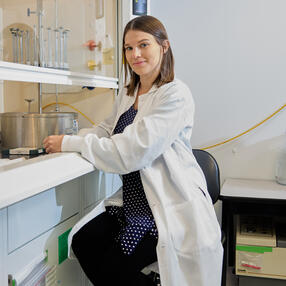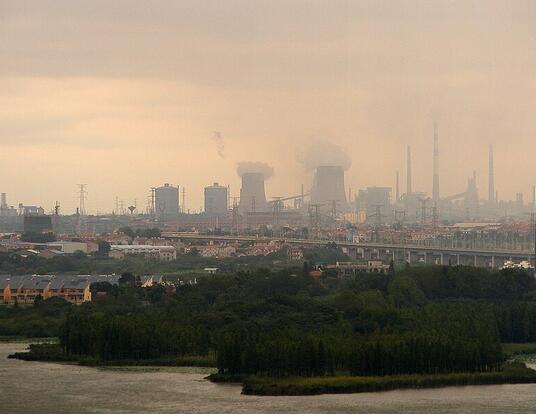Before ‘Forever’
Tracking down precursors to the persistent toxic chemicals that contaminate our water and food

Research at Risk: Since World War II, universities have worked with the federal government to create an innovation ecosystem that has yielded life-changing progress. Now much of that work may be halted as funding is withdrawn. Find out more about the threats to medical, engineering, and scientific research, as well as how Harvard is fighting to preserve this work—and the University's core values.

You should know three things about per- and polyfluoroalkyl substances (PFAS). The first is that these chemical compounds are persistent. The strength of their bonds prevents them from breaking down in the natural environment. The second is that they’re everywhere; PFAS are used in cookware, carpeting, cosmetics, and many other consumer products. The last and probably most important thing to know is that PFAS are probably bad for you. The chemicals are associated with widespread negative impacts on health.
“[The scientific community has reached] good consensus that PFAS exposures are associated with certain health effects,” says 2024 Harvard Horizons Scholar Heidi Pickard, a PhD student in engineering sciences. “Some of these effects include liver disease, decreased fertility and hypertension in pregnant women, immune and developmental effects in children including decreased antibody response to vaccines, and certain organ cancers.”
The good news is that private industry is shifting away from the production of certain types of PFAS—largely in response to regulation like the PFAS Strategic Roadmap announced by the Environmental Protection Agency in 2021. The bad news is that the shift is usually to different kinds of PFAS. Alarmingly little is known about these substances, many of which are referred to as PFAS precursors. Pickard’s Horizons project, “Investigating Environmental Contamination and Human Exposure to Overlooked and Difficult to Measure Chemical Compounds,” seeks to uncover the prevalence of these precursors in our water and food, and assess the impacts on the environment and health.
The Problem with PFAS
Per- and polyfluoroalkyl substances are a class of organofluorines, organic compounds that contain carbon-fluorine (C-F) bonds. This bond gives PFAS some unique properties. The fact that they repel oil and water, are stain-resistant, and non-stick, for instance, make PFAS attractive for use in consumer products that range from carpeting and furniture to food packaging, outdoor gear, cosmetics, cookware, and aqueous film-forming foam (AFFF) used to fight fires. But that C-F bond is also what makes PFAS so difficult to get rid of.
“The C-F bond is one of the strongest bonds in nature,” she says. “That makes these compounds very resistant to breaking down in the natural environment. They’re very persistent under normal environmental conditions. That’s why they’re called ‘forever chemicals.’”
Because PFAS don’t break down, they build up in the environment and eventually in our bodies through the food we eat, the water we drink, the air we breathe, and the things we touch. They can even be transferred from mother to child through breastfeeding. Laboratory studies indicate that the levels at which PFAS accumulate in humans and animals can be associated with troubling health effects. “The Agency for Toxic Substances and Disease Registry published in 2021 an extensive review of epidemiological studies for 14 PFAS compounds, summarizing the associated negative health effects with them,” Pickard notes.
Moreover, because PFAS are so persistent and so widely used, the contamination problem is widespread. The chemicals have been detected not just at industrial sites and adjacent areas, but also in the high Arctic, the Antarctic, and remote islands—all locations far from sources of contamination. The PFAS Project Lab at Northeastern University created a map that identified almost 58,000 sites in the US suspected of PFAS contamination. An estimated 98 percent of the US population has detectable levels of the chemicals in their blood.
The C-F bond is one of the strongest bonds in nature. [It] makes these compounds very resistant to breaking down in the natural environment . . . That’s why they’re called ‘forever chemicals.’
—Heidi Pickard
“PFAS are released into the air from manufacturing and can transport long distances,” Pickard says. “They leach into the soil and groundwater from industrial waste or consumer products in landfills and from fire-fighting foam. The effluent and biosolids from wastewater treatment processes that don’t remove these chemicals get released into waterways and are used as fertilizer, contaminating farmland. These are just some of the ways that these chemicals get into our groundwater, drinking water, surface waters, soil, and air. They then get taken up into plants and accumulate in biota. Anywhere you look for PFAS, you’ll probably find them.”
Sounding the Alarm
Not surprisingly, PFAS have increasingly become a concern for environmental regulators in recent decades, particularly the chemical perfluorooctane sulfonate (PFOS), originally produced by the American multinational conglomerate 3M. “At least 17 states at this point have fish consumption guidelines related to PFAS that focus on the PFOS chemical because it’s the one that’s detected at high concentrations in freshwater fish and we know it’s associated with toxic effects through exposure and consumption,” Pickard says. “PFOS has been phased out of production in North America but the compound is still found in high concentrations at sites across the country and it’s still accumulating because it is persistent and other precursor PFAS are breaking down to it over time.”
In response to the regulatory crackdown, industries have shifted to using polyfluorinated substances that are usually precursor PFAS. Unlike terminal PFAS, precursors do break down, which allows manufacturers and others to evade regulation. But the degradation is only partial, leaving the precursor’s terminal PFAS component in the natural environment. “The problem is that we don’t have analytical standards to quantitatively determine if precursor PFAS are in the environment and at what levels,” Pickard says.
That’s where her Horizons project comes in. Pickard used a combination of methods to assess the full extent of PFAS contamination and analyzed the muscle tissue of eight species of recreational freshwater fish caught in southern New Hampshire. In all samples, she found traces of precursor PFAS associated with the electrochemical fluorination process historically used in manufacturing. “People rely on these fish for food,” she says. “We don’t know what levels of exposure to these precursors could be a concern, but identifying their presence and potential to accumulate in biota is the first step.”
Pickard also studied surface waters downstream of a military base in Cape Cod, Massachusetts where AFFF was used to train firefighters. “Aqueous film-forming foam is one of the largest sources of PFAS,” she explains. “It’s used at almost every military base and airport across the United States, so there are hundreds if not thousands of these sites. But we have limited understanding of the extent of contamination present in nearby ecosystems and which PFAS used in the foam are accumulating in fish around these sites—particularly those that are consumed by local fishers or indigenous communities in the area.”
Pickard analyzed a variety of Cape Cod fish species consumed by the indigenous Mashpee Wampanoag and others. She found high concentrations of PFOS in the fish, the chemical most frequently regulated because of its well-known toxicity, but there were also abundant precursor PFAS present in the fish.
“There is one class of precursors called perfluoroalkyl sulfonamides, which have a very similar molecular structure to PFOS, only with a sulfonamide head group on the end,” Pickard explains. “These precursors can break down to PFOS or other similar terminal compounds depending on the carbon chain length of the molecule. But what we're finding is that those chemicals aren't breaking down. They persist for a long time and accumulate at high concentrations in the fish.”
[Heidi's] work has direct relevance to regulations for these compounds such as fish consumption advisories and water quality protection.
—Professor Elsie Sunderland
This last finding—about the resilience of precursors and the levels at which they accumulate in biota—is one Pickard says should concern regulators and the public. “My work is trying to sound the alarm,” she asserts. “These precursors we've assumed aren’t a problem probably are. So, we need to include them in regular biomonitoring and conduct toxicity assessments to identify whether or not exposure to these types of chemicals is important for fish consumers.”
Mitigating Risk

Pickard's advisor Elsie M. Sunderland, professor of environmental science and engineering, says that exposure to PFAS is often underestimated because of a failure to take precursors into account. Her advisee’s research will fill that gap.
“Heidi is investigating less understood exposure pathways to PFAS and also the potential for precursors to bioaccumulate in food webs,” she says. “Her work has direct relevance to regulations for these compounds such as fish consumption advisories and water quality protection. It’s also pushing communities to think about new ways to detect and report these compounds when they are present in the environment.”
Pickard’s research will also provide a toolbox of analytical methods that will enable researchers to better assess the full extent of PFAS contamination in the environment and to link the transport of PFAS from source sites to fish consumed by wildlife and humans—particularly members of indigenous communities who rely on their local catch as a food source. She hopes that understanding how these toxic chemicals accumulate and behave in the environment will enable local officials to better mitigate the risk that PFAS pose.
“In addition to understanding how precursors behave and accumulate in biota,” she says, “my results will hopefully also be used by local or state governments to establish necessary fish and water advisories in their areas for risk mitigation. My hope is also that more agencies will start thinking about precursors as an important part of our PFAS exposures. We must account for precursors when assessing biological exposure to PFAS, especially if a lot of these precursors are entering food chains, bioaccumulating in organisms, and biotransforming to substances that have known toxicological effects.”
Learn more about the 2024 Harvard Horizons Scholars and see them on stage at the campus-wide Harvard Horizons Symposium in Sanders Theatre on April 9.
Get the Latest Updates
Join Our Newsletter
Subscribe to Colloquy Podcast
Simplecast





